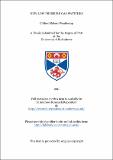Files in this item
New low pressure gas switches
Item metadata
| dc.contributor.advisor | Maitland, Arthur | |
| dc.contributor.author | Weatherup, Clifford Robert | |
| dc.coverage.spatial | 328p, 7p of plates. | en_US |
| dc.date.accessioned | 2018-06-14T08:47:03Z | |
| dc.date.available | 2018-06-14T08:47:03Z | |
| dc.date.issued | 1991-07 | |
| dc.identifier.uri | https://hdl.handle.net/10023/14040 | |
| dc.description.abstract | This thesis describes an investigation the aim of which was the development of low pressure gas switches with the advantages of zero standby power consumption and instant readiness. Hydrogen thyratrons use a hollow anode to give the switch a convenient reverse conduction capability. The hollow anode structure has been shown to pass a 4 kA pulse current at 500 Hz for 10<super>10 </super>shots. The use of the hollow anode structure as a cold cathode for a low pressure switch is proposed and triggering of the structure by ions is demonstrated. Under conditions of low gas pressure and high discharge voltage, electrons make few collisions in the cathode dark space of a glow discharge and form extensive beams which travel many centimetres in the gas. Current/voltage characteristics of this 'electron beam' type of discharge are presented for deuterium at pressures between 0.2 and 1.0 torr. The electron beam discharge was found to be space-charge limited with I V3/2 at pressures below about 0.25 torr and I V3/2 at pressures above about 0.25 torr. It is proposed that the current in the electron beam discharge is limited by the flow of positive ions in the cathode dark space. Control of the emission area of a discharge in a hollow metal cylinder is demonstrated and is used as a triggering method for a new type of low pressure gas switch. Tests in a pulse modulator at repetition rates up to 1 kHz show that the switch operates satisfactorily. The triggering mechanism is shown to depend on the properties of the cold cathode glow discharge which, in certain circumstances, leads to the unusual phenomenon of post trigger-pulse firing of the switch. The phenomenon is shown to result from the interaction of the trigger discharge cathode dark space and the geometry of the switch. The glow discharge electron beam is successfully applied as a triggering method in several new low pressure gas switches. In one arrangement, the electron beam is used to pre-ionise the switch and subsidiary grids are used to trigger main conduction. In another arrangement, the electron beam is directed into the high voltage region to trigger conduction directly. The designs of these switches are discussed and their operation is demonstrated. | en_US |
| dc.language.iso | en | en_US |
| dc.publisher | University of St Andrews | |
| dc.subject.lcc | TK7871.84S9W3 | |
| dc.subject.lcsh | Gas Tubes | |
| dc.title | New low pressure gas switches | en_US |
| dc.type | Thesis | en_US |
| dc.type.qualificationlevel | Doctoral | en_US |
| dc.type.qualificationname | PhD Doctor of Philosophy | en_US |
| dc.publisher.institution | The University of St Andrews | en_US |
This item appears in the following Collection(s)
Items in the St Andrews Research Repository are protected by copyright, with all rights reserved, unless otherwise indicated.

